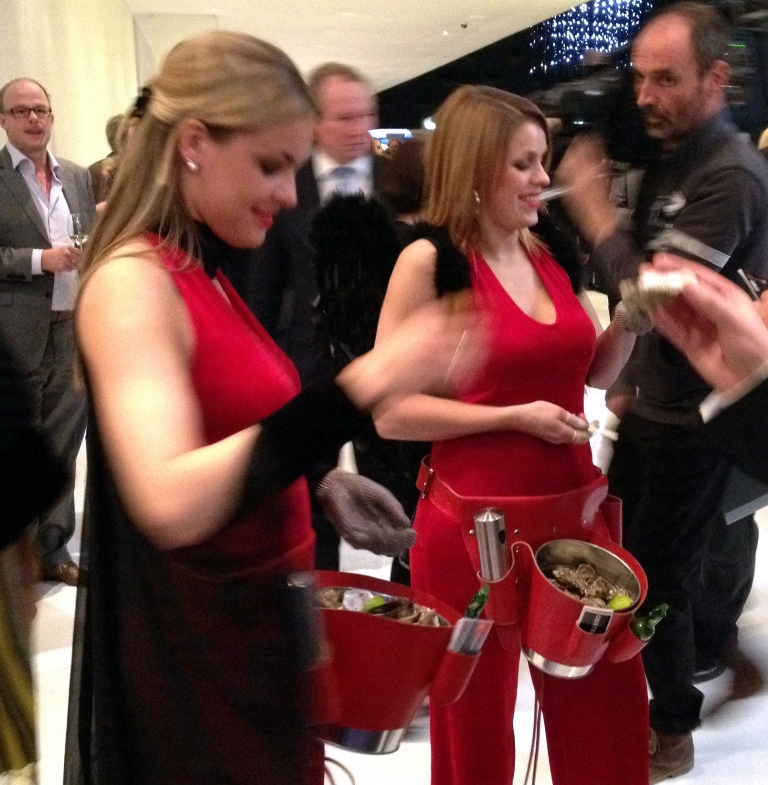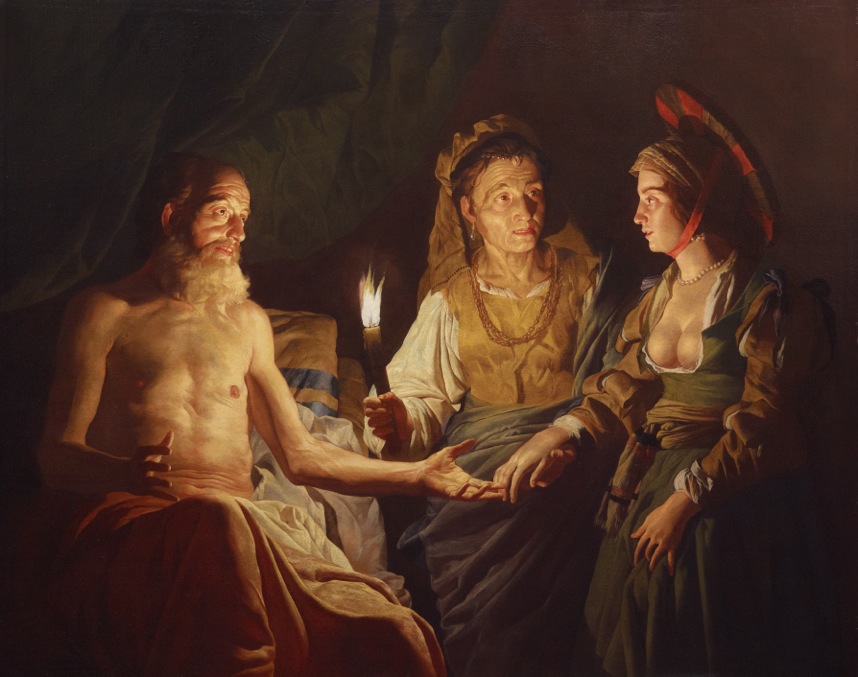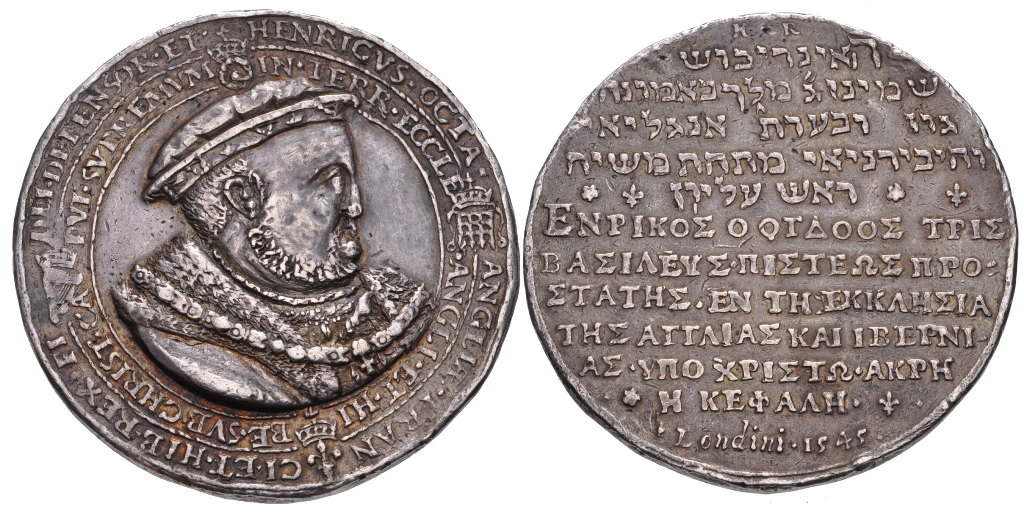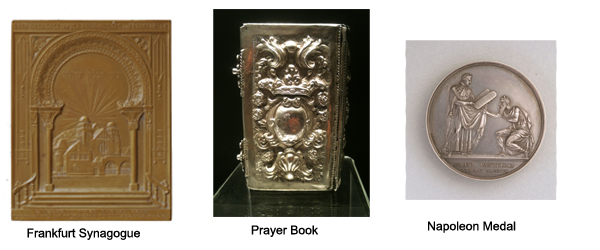One wouldn't necessarily expect to find The European Fine Art Fair (TEFAF) Maastricht to be bursting at the seams with faith. If the art auction and fair worships at any altar, it would be Mammon's rather than Apollo's. The notion that a camel has a better chance of crawling through the eye of a needle than a rich man does of setting up shop in heaven couldn't be further from the culture of TEFAF, whose press releases talk of 170 private jets descending on the Maastricht airport and about 65,000 tulips adorning the halls of the convention center.
 The scenery one sees as one nears the end of the two-hour drive from Amsterdam to Maastricht, a historic city located in the southern-most tip of the Netherlands, doesn't necessarily inspire one to anticipate great art. One enters Maastricht on a highway flanked by an industrial skyline panorama of smokestacks and warehouses. But as one gets closer to the city center, one encounters a much more picturesque vision of medieval battlements and the dominating presence of the Meuse river.
The scenery one sees as one nears the end of the two-hour drive from Amsterdam to Maastricht, a historic city located in the southern-most tip of the Netherlands, doesn't necessarily inspire one to anticipate great art. One enters Maastricht on a highway flanked by an industrial skyline panorama of smokestacks and warehouses. But as one gets closer to the city center, one encounters a much more picturesque vision of medieval battlements and the dominating presence of the Meuse river.
At the fair -- which is celebrating its 25th anniversary, and which ran from March 16 to March 25 -- more than 250 dealers from nearly 20 countries sell their wares, which span from Greek and Roman antiquities to contemporary sculptures. Calvin Klein was among the collectors at the fair, which draws museum acquisitions staff and other purchasers with deep pockets. One early sale, for example, was a Peter Paul Rubens Crucifixion, which had an asking price of €3.5 million (Bernheimer Fine Old Masters).
But whatever the odds, there was a lot to be said about religion and religious art at TEFAF. In virtually ever section of the fair -- paintings, antiques, modern, manuscripts, classical antiquities, design, works on paper and jewelry -- there were at least dozens of examples of fascinating works with religious content and themes (and, to be fair, many not so interesting works). Here are three noteworthy trends:
1. Obscure Old Testament Scenes Galore
In the set of biblical paintings, New Testament scenes tend to overwhelmingly dominate Old Testament depictions, and even in the relatively small set of scenes from the Jewish Bible, some biblical episodes are rarely portrayed. The scene that Matthias Stomer renders in his painting Sarai Offering Hagar to Abram (Galerie Sanct Lucas) is based on Genesis 16.
 Sarah (then named Sarai) realizes that she's barren, so she somehow musters the courage to offer her husband, Abraham, her handmaiden Hagar as a second wife. It's an awkward scene to be sure, and it's no surprise that artists have latched onto other scenes from the chapter, including Sarai dismissing Hagar and Ishmael, Hagar's isolation in the desert with Ishmael, and Hagar's conversation with the angel.
Sarah (then named Sarai) realizes that she's barren, so she somehow musters the courage to offer her husband, Abraham, her handmaiden Hagar as a second wife. It's an awkward scene to be sure, and it's no surprise that artists have latched onto other scenes from the chapter, including Sarai dismissing Hagar and Ishmael, Hagar's isolation in the desert with Ishmael, and Hagar's conversation with the angel.
Half a century or so later, the Dutch painter Adriaen van der Werff would render the same scene with a voluptuous and nude Hagar sitting on a bed beside Abraham, who is young and muscular. But there seem to be very few versions of the work before Stomer tackled it. And Stomer's choice to depict Abraham as the old man he was -- 86 according to Genesis 16:16 -- stands in sharp contrast to the decision van der Werff would make.
It's hard not to imagine a wealthy old man with an attractive girlfriend who looks old enough to be his daughter (or granddaughter) when one studies Stomer's painting. Sarai looks to be of Abraham's generation, and her modest attire is intentionally juxtaposed with Hagar's exposed cleavage. It's far easier to read Genesis 16:16 and to gloss over the words, but it's difficult not to be troubled by the view that Stomer presents.
Other notable mentions in the Old Testament art department are Domenico Gargiulo's The Gathering of the Manna (Galleria Silvano Lodi & Due), another rarely depicted scene, and a particularly dramatic Judgement of Solomon (by Gaetano Gandolfi, at Jean-François Heim). A discovery of Moses by Nicolas Colombel (c. 1680-90) at Richard Feigen & Co. depicts a most un-Egyptian Egypt (complete with a a decidedly un-biblical reclining river god), and two Delftware dishes (one with Adam and Eve, and the other a sacrifice of Isaac) at Aronson Antiquairs are particularly gorgeous. And Galerie Eric Coatalem's seven-part series on the biblical Esther and Mordecai (Histoire d'Esther) by Jean François de Troy alone was worth the trip.
2. Biblical Hebrew Is Anything But A Dead Language
Not only did Old Testament scenes show up in a big way at TEFAF, but Hebrew inscriptions could be found in several of the booths. A silver supremacy medal for Henry VIII at Nomos contains Hebrew, Greek and Latin inscriptions, which basically declare the king -- portrayed on the front of the medal wearing what appears to be the Order of the Golden Fleece -- the "supreme head of the Church of England and Ireland."
 Henry VIII needed all the help in this regard as he could get, as he was trying to justify his divorce from Catherine of Aragon, and subsequent marriage to Anne Boleyn.
Henry VIII needed all the help in this regard as he could get, as he was trying to justify his divorce from Catherine of Aragon, and subsequent marriage to Anne Boleyn.
A close inspection of the Hebrew inscription reveals some pseudo-Hebraic words and the prominence of the word Messiah, but, as Richard Bishop observes in a Hebraica Veritas essay on the subject, the Hebrew was an attempt to marshal Old Testament legitimacy for his controversial divorce.
"No doubt Henry greatly approved of this medal. The message was loud and clear. His title 'Supreme Head' spelt out in Hebrew, Greek, and Latin, proclaimed to the world that the combined learning of all traditions, Hebraic, Greek and Roman, the Old and the New Testaments, all supported his claim to be God's appointed Head of the Church," Bishop writes.
Another medal with Hebrew inscriptions appears in the Tradart booth, this one a bronze plate commemorating the inauguration of Frankfurt's synagogue. The Hebrew inscription, "house of prayer of the upright" (depending on how one translates Yeshurun), appears above a sun setting (or rising) over the Frankfurt synagogue. Some of the floral details adorning the arch over the Hebrew inscription and along the sides of the plate resemble the shape of the Hebrew letter Shin, the first letter of one of the divine names. And beneath the synagogue representation, another Hebrew inscription offers the Hebrew date of the inauguration.

Two other pieces merit attention: a 1699 Sephardic Jewish prayer book from Venice (yours for €42,000) at Kunstzalen A. Vecht, with a silver cover by Atonio Poma, and another Tradart masterpiece, an 1806 bronze medal depicting Napoleon I holding the 10 Commandments. The personification of the Jewish community (portrayed as Michelangelo's Moses with horns) bows at Napoleon's feet, signifying his/its appreciation of the emancipation (relatively speaking) of the Jews in the French empire.
3. Whatever Happened To Islam?
If TEFAF can be applauded for its comprehensive showcase of Christian art, and it's surprising attention to Jewish art, it comes up very short in the third Abrahamic faith. Although some booths -- notably Gregg Baker Asian Art, Marcel Nies Oriental Art, Vanderven & Vanderven Oriental Art and Jacqueline Simcox -- showed stunning Buddhist and Hindu art, an inspection of every booth didn't turn up a single work of Islamic art.
A search of the TEFAF catalog for the terms "Islam," "Muslim" and "Islamic" yields no results. One dealer, Sam Fogg, has a focus on Islamic art, but the gallery didn't respond to interview requests. The closest pieces (which are far afield indeed) are a watch with "Islamic" numerals made for the Turkish market (Somlo Antiques) and another watch at Crijns & Stender with Arabic numerals.
Excuse the pun, but it's high time for a major art fair like TEFAF to show more Islamic art than a couple of watches.
Full disclosure: This writer's trip to TEFAF was funded, in large part, by the Netherlands Board of Tourism & Conventions, which, however, had no role whatsoever in or oversight over this article. This article originally appeared on the website of the Houston Chronicle.